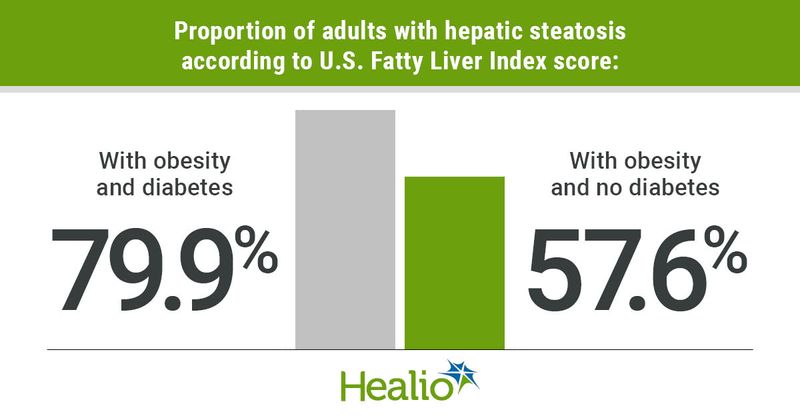Hepatic steatosis observed in most adults with obesity, diabetes
Nearly 80% of U.S. adults with obesity and diabetes have hepatic steatosis and an increased risk for advanced fibrosis, according to study findings published in Obesity.

“In people with diabetes, even those in the early stages of obesity, the majority had steatosis, and the prevalence of fibrosis was high,” Kenneth Cusi, MD, FACP, FACE, chief of the division of endocrinology, diabetes and metabolism at the University of Florida and an Endocrine Today Editorial Board Member, told Healio. “The risk for fibrosis is much higher than we previously thought.”

Cusi and colleagues analyzed data from the National Health and Nutrition Examination Survey from 2015 and 2016. Adults aged 18 years and older who had laboratory results available, no evidence of substantial alcohol consumption and a BMI of 25 kg/m2 or higher were included. Participants with a Fatty Liver Index (FLI) score of more than 60 or a U.S. Fatty Liver Index (USFLI) score of greater than 30 were defined as having nonalcoholic fatty liver disease (NAFLD). The Fibrosis-4 (FIB-4) index was used to determine fibrosis risk. Risk for advanced liver fibrosis was deemed low with a score of less than 1.67 and high with a score of greater than 2.67. NAFLD fibrosis score (NFS) was also used to determine fibrosis risks, with a score of greater than 0.676 defined as high risk.
Steatosis common with obesity, diabetes
Of 3,841 adults included in the study, 56% had obesity and 21.7% had diabetes. When USFLI score was used, more adults with overweight and diabetes had hepatic steatosis compared with those with overweight without diabetes (48.3% vs. 17.4%; P < .01). Similarly, more adults with obesity and diabetes had hepatic steatosis compared with those with obesity and no diabetes (79.9% vs. 57.6%; P < .01).
When FIB-4 score was used, adults with diabetes had a higher prevalence of moderate to advanced fibrosis compared with those without diabetes (31.8% vs. 20.1%; P < .05). Moderate risk for advanced fibrosis was observed in 24.9% of adults with obesity and diabetes compared with 13.7% of those with obesity and no diabetes (P < .05). When NFS score was used, advanced fibrosis was seen among more adults with obesity and diabetes than among those without diabetes (34.1% vs. 6.4%; P < .001).
Obesity plus diabetes increases advanced fibrosis odds
In logistic regression models adjusting for age, adults with obesity and diabetes had a moderate to high risk for fibrosis as measured by FIB-4 (OR = 2.06; 95% CI, 1.3-3.25) and advanced fibrosis as measured by NFS (OR = 5.7; 95% CI, 3.74-8.68). Of adults aged 45 to 64 years, those with obesity and diabetes had a higher prevalence of those with a moderate to high risk for fibrosis compared with those without diabetes (26.3% vs. 8.6%; P < .01).
Cusi said the findings emphasize the importance of screening high-risk patients for NAFLD. As Healio previously reported, in an article published in Gastroenterology, Cusi and colleagues outlined steps providers should take with screening. The steps include analyzing a patient’s history and laboratory tests; noninvasive testing for fibrosis, such as calculating FIB-4; and using liver stiffness measurement for those with an indeterminate risk after FIB-4 is calculated.
“Providers need to pay attention to the high-risk groups: people with obesity, metabolic syndrome, type 2 diabetes and high liver enzymes,” Cusi said. “Those are the groups at the highest risk for cirrhosis. If you do something to treat these patients early on, you can prevent cirrhosis.”
Reference:
Kanwal F, et al. Gastroenterology. 2021;doi:10.1053/j.gastro.2021.07.049.
For more information:
Kenneth Cusi, MD, FACP, FACE, can be reached at kenneth.cusi@medicine.ufl.edu.
